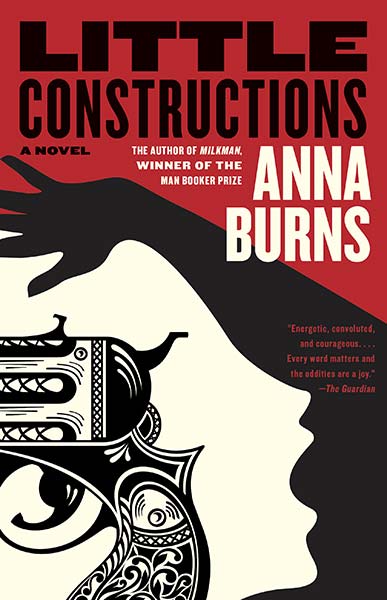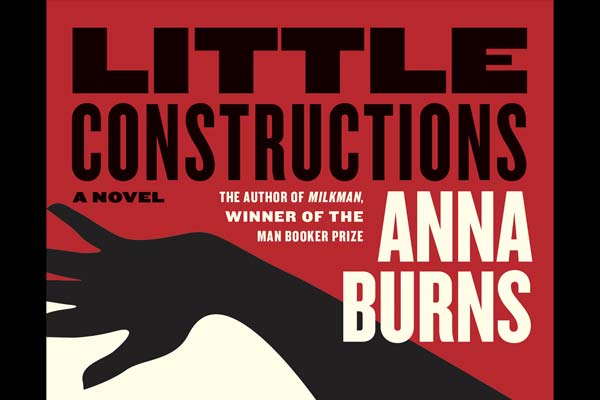Eye on the Indies:
A Look at Indie Authors and Their Publishers
By Lanie Tankard, Indie Book Review Editor
Little Constructions: A Novel by Anna Burns (Minneapolis, Minnesota: Graywolf Press, February 18, 2020; 312 pages; $16.00; paperback ISBN 978-1-64445-013-0). First published in Great Britain by Fourth Estate in 2007.
“In violence, we forget who we are….”
—Mary McCarthy,
On the Contrary: Articles of Belief 1946-1961 (p. 276)

Eleven years before the Booker-winning novel Milkman came out, Anna Burns published Little Constructions in Great Britain. Now Graywolf Press has reissued her earlier book in the United States, wisely bringing attention back to it. Not only is Little Constructions still a timely window into guns, gender, and domestic violence, but it’s also an excellent study in how Burns developed the voice that snagged the Booker.
Milkman is stronger, but Burns already had a prize-winning first novel (No Bones, 2001) before Little Constructions, and she published a novella (Mostly Hero, 2014) after. So it’s no surprise that her voice, like fine wine, had aged to perfection by the time Milkman appeared in 2018. It’s fun to come across foreshadowings here—early versions of the vague Mr. McSomebody and a cheeky narrator, both of which she honed in her Booker book. Unlike middle sister in Milkman, however, the voice of Little Constructions remains disembodied.
Little Constructions is set in the fictional town of Tiptoe Floorboard, where men and guns definitely dominate and John Doe is the kingpin. That town has a whole slew of Does, as a matter of fact, and all their first names start with the letter J. Besides John, there’s Jetty, Jotty, Janet, Julie, Judas, JimmyJesus, JesseJudges (known as JayJay), JohnJoe, Jane…whew! It takes a while to sort them all out, and even then it’s hard to keep them straight. At times, it’s impossible. An aura of magical realism surrounds Tiptoe Floorboard in misty surreality. Reading this Northern Irish author is definitely a mental workout.
Quite frankly, Little Constructions is an insane novel. The people in it are insane. Good Lord, who can make sense of this book? And yet…and yet…just look around. We are living in insane times. The chaos of the novel becomes a larger commentary on violence anywhere, anytime. That can be an effective metaphorical literary device, which Burns employs here to expand violence in any way, shape, or form—especially by men against women—but it may still leave a reader wondering, “What was all that about?!”
Which may, indeed, have been what Burns was striving for: to inspire people to ponder. The storyline is disjointed, yet so is stream of consciousness. Our thought processes constitute one huge labyrinth. Deep within is where violence victims hide memories of rape and incest and beatings. Burns portrays masterfully the little white lies (“little constructions”) her characters tell themselves to dissociate while undergoing such physically violent affronts. They imagine another world in order to survive, focusing on details in the wallpaper or clouds in the sky to zone out—until years later, the built environment of their subconscious crumbles, unleashing PTSD or a #MeToo movement. Are some Tiptoe Floorboard citizens perhaps little constructions themselves, conjured up by other characters as face-saving alter egos to whitewash traumatic memories?
Burns is inventive the way she works in neurological phenomena, mimicking seemingly random thoughts bouncing around a protagonist’s mind. Psychological terms have long been drawn from literary allusions: Werther syndrome (clusters of suicides from Goethe’s The Sorrows of Young Werther) and Clytemnestra complex (think Agamemnon from Homer’s The Iliad), for example. Burns reverses the technique, mashing up faux-DSM psychiatric classifications to create diagnoses such as Spatial Fragmentation Hallucination Syndrome or Jumbled Time Syndrome Imprecision. This jargon offers her narrator literary and emotional distance for delving into present repercussions of past indiscretions in Tiptoe Floorboard. Character vagueness strengthens the idea that identifying details are not necessarily crucial to a plot. Burns seems to be saying to her audience here: Hey, construct your own character images as you read, why don’t you?
Once Burns lets loose her uniquely unstoppable style, she’s unputdownable. She has a knack for spinning humor into the darkest of topics while also imbuing them with poignancy. That combination results in powerful journalistic editorializing when encased in the form of a novel, far more effective than a nonfictional recitation of facts. Burns can make an ironic point by the mere capitalization of a word. She brandishes absurdity as a cudgel. Look out: It’s Whoa Nelly, starting right there on the first page of Little Constructions when one of those Doe women barges into Tom’s gun shop and demands a weapon.
“Gimme a gun,” cries Jetty. Then out she runs with a Kalashnikov and hops into a taxi. Tom (Spaders, the gunshop owner—you remember) had been talking to his friend, Tom Cusack (let’s just call him Customer Tom to keep things straight), who turned back to Owner Tom spluttering that Jetty didn’t even care what kind of gun it was.
“You heard her: ‘Just, just any…that one there. Gimme that one,’ she said.” The two men shake their heads in communal exasperation at women in general. Meanwhile, readers are running out the door to see what Jetty plans to do with that gun. From then on, it’s “Katy, bar the door!” as Burns loads her rifle with ink and fires it at every aspect of male/female relations—even minutiae such as how to give undetected advice. Like that time Jotty Doe advised Owner Tom to get rid of the guns and he insisted it wasn’t his responsibility what people did with the guns they bought at his shop. So he got rid of Jotty instead.

Photo by Eleni Stefanou
The trigger-happy narrator fires a symbolic Kalashnikov at sexual violence, blasts IRA Troubles lingering from the Seventies, and shoots right through the Fourth Dimension boundary. Burns creates a virtual tesseract, a literary cube within a cube, as a safe haven in her novel for survivors of rape, incest, and domestic violence. It’s reminiscent of the Undertomb and Labyrinth of Arha/Tenar, priestess of the Nameless Ones, in Ursula K. Le Guin’s The Tombs of Atuan (Earthsea Series #2).
Burns fashions storyline, narration, metaphor, and parody into a laser beam to focus on larger social issues—into which she digs deeply, using social psychology as her shovel. She assigns collusion a role in her tale, ingeniously costuming it in the bystander effect from Bibb Latané and John Darley’s research on the 1964 New York murder of Kitty Genovese. When “Ordinary Decent Folk” start amassing in Tiptoe Floorboard while turning a blind eye to violence, the narrator rightly wonders whether times have really changed for women. Score one for the females in this novel though, for by the end they’ve turned that gun shop into a bra boutique.
Little Constructions dazzles. One might subtitle it: “Guns, Gals, and Grit.”
Born in Belfast, Northern Ireland, Anna Burns now lives in East Sussex, England. She’s the author of three novels—No Bones (2001), Little Constructions (2007), and Milkman (2018)—in addition to a novella: Mostly Hero (2014). No Bones won the 2001 Winifred Holtby Memorial Prize from the Royal Society of Literature and was shortlisted for the 2002 Orange Prize for Fiction. In 2018, Milkman won the Man Booker Prize and the National Book Critics Circle Award for Fiction. In 2019, Milkman won the Orwell Prize for political writing in fiction, and was a finalist for both the Rathbones Folio Prize and the Women’s Prize for Fiction.
W.W. Norton published the US edition of No Bones (2002, still in print). Anna Burns originally self-published Mostly Hero online as a Kindle single (2014). Recently Faber & Faber in London brought out a paperback edition (October 2019). Graywolf published the US edition of Milkman in 2018.
Publisher: Graywolf Press
 Graywolf Press in Minneapolis is a nonprofit literary publisher of poetry, fiction, nonfiction, and work in translation. The press has been publishing books for over forty-five years (distributed by Farrar, Straus & Giroux since 2002).
Graywolf Press in Minneapolis is a nonprofit literary publisher of poetry, fiction, nonfiction, and work in translation. The press has been publishing books for over forty-five years (distributed by Farrar, Straus & Giroux since 2002).
Scott Walker founded Graywolf in 1974 in Port Townsend, Washington. Fiona McCrae has served as director and publisher since 1994. She is also vice chair of the Board of Directors of the National Book Foundation. During the 2015 opening of an exhibit on the Graywolf archives housed at the University of Minnesota, McCrae said: “Sometimes people have asked me what defines…a Graywolf writer…. And one of our answers is that they don’t sound like anybody else.”
Graywolf seeks works “that combine a distinct voice with a distinct vision,” and collaborates to publish award winners from various organizations offering literary prizes: Walt Whitman Award, Cave Canem Poetry Prize, Emily Dickinson First Book Award, and the Summer Literary Seminars Unified Literary Contests. The press also publishes several books per year from A Public Space, an independent magazine of literature and culture based in Brooklyn. The Lannan Translations Series, which supports the English translation and publication of new works, has awarded a literary grant to Graywolf since 2002. Along with other grants, Lannan enables the nonprofit press to publish two translated books per year.
Graywolf’s mission statement emphasizes: “We champion outstanding writers at all stages of their careers to ensure that adventurous readers can find underrepresented and diverse voices in a crowded marketplace.” In addition, it notes a commitment “to making our books, programming, publishing process, and workplace accessible to communities and individuals of all backgrounds and abilities.”
Author submission guidelines for Graywolf Press are available on the website. The press offers internships in the publishing areas of development, editorial, and marketing and publicity.
Copyright 2020 Woven Tale Press LLC. All Rights Reserved

